Manchester tends to hog the national spotlight when it comes to the achievements of the so-called Northern Powerhouse – but to the west of the city, just a stone’s throw away, is where lies the north’s true sleeping giant. Meet Salford, a revolutionary smart city that promises to break the mould in the UK by navigating some yet-uncharted digital waters
“That’s a residential block over there,” said Jon Corner, pointing to a building outside the fourth-floor window of The Landing, the one-stop shop for innovation at MediaCityUK. “See this other block right in front of us? That wasn’t there last year, it’s brand new: it opened in December, just before Christmas. There are people living in there already – in fact, every flat has been sold.
“This other one finished about two weeks ago,” he continued, gesturing to another building as he squeezed past a pair of construction workers who were transforming the empty space around us into another set of offices. “That’s why there’s no one there yet. And that’s the set of Coronation Street, way back there!”
As we walked through the many flexible workspaces peppered throughout The Landing’s five floors – all of which have been designed by different people, in distinct styles – Jon was stopped by several people, most of them young and casually dressed, for animated chats. He’s a familiar face around those parts – not just because he’s the building’s CEO and Salford’s first-ever chief digital officer, but because he actually puts in the time to meet with The Landing’s many tenants, all of whom benefit from boundless access to his professional guidance.
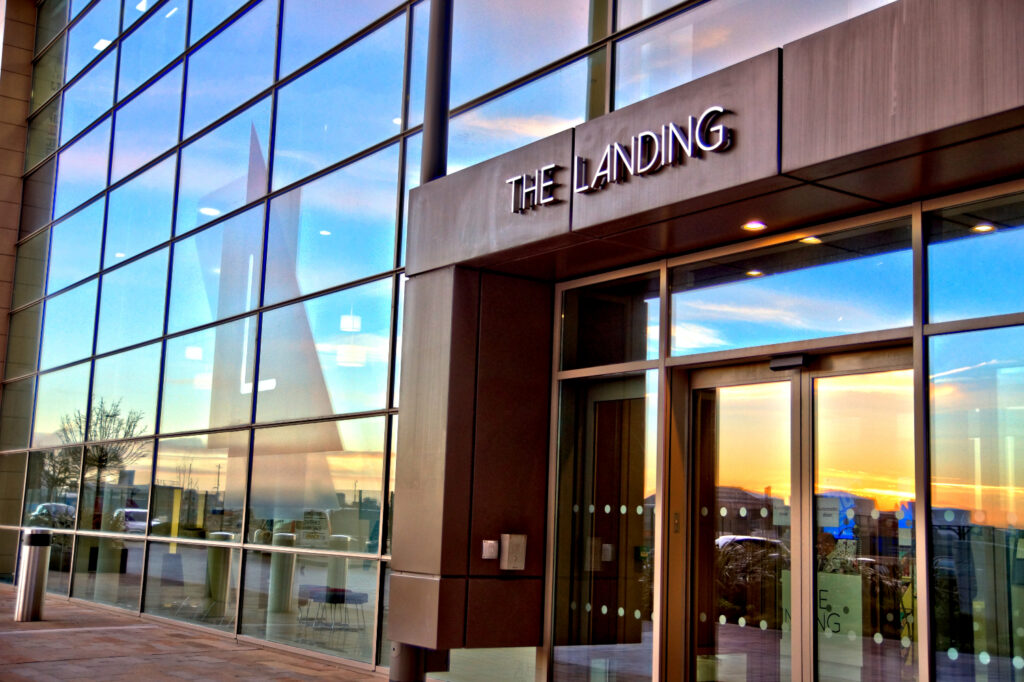
For the lucky start-ups housed in the building, Jon is a tech mentor. He’s taken it upon himself to offer specialist advice to the digital SMEs who have chosen to adopt The Landing as their second home – and that choice is not without reason. A major sweetener for setting up shop in the building, whether that’s in a co-working environment or in a private office, is the broad cross-section of professional advice available at your fingertips. As well as Jon’s expertise, tenants can take advantage of the capabilities of organisations such as Vodafone (which runs an open-door policy in its 5G Digital Innovation Hub, complete with IoT services, 5G wireless routers, and gigabit-capable optical-fibre links), Barclays (with its onsite Eagle Lab offering the medical community access to everything from laser cutting equipment to 3D printing), or the Digital Catapult (and the many virtual and augmented reality headsets available in its Immersive Lab). For the start-ups and SMEs on site, The Landing is more than just where they work: it’s a highly-connected testing site for all their latest digital prototypes, situated right at the heart of what is arguably the UK’s most advanced urban living lab.
“The Landing is full of labs and testing areas where companies can build their own product, test it, and ultimately prove it,” commented Jon. “We also have a lot of social space where they can meet investors, as well as something called the Network Benefits programme, where we wrap services around our companies. If you need recruitment, marketing or business advice, we have a whole network of specialists who are constantly working with our businesses. You don’t just get a tenancy in The Landing – you get a membership.”
The building can accommodate anywhere between 80 and 120 companies at a time, with many of these starting out as microbusinesses and rapidly blossoming into something more. “Several of our start-ups come in with just a desk, still finding their feet as a company, and then suddenly notice that they’re growing really quickly,” explained The Landing’s CEO, who has seen the building flourish from a mere idea on paper to a booming tech incubator. “As a result, we have quite a lot of pressure on us to find more office space – which is good pressure to manage, since it’s nice to see that bubbling up. We have companies that have grown so rapidly that we then have to staircase them into the rest of MediaCityUK, giving them over to Peel Group, which manages the wider estate. Over the last three years, more than 120 companies have graduated out of the building.
“That’s what we’re about: we’re here to help small companies, to give them an opportunity to get the very best environment and access to technology specialists, and to do that all at an affordable, entry-level cost. Then as they grow, we start to make those costs more realistic, until they get to a point where it’s time to leave us.”
A mini Shenzhen
When Cityscape visited The Landing, Jon and his team were getting ready to host hundreds of visitors for a special afternoon with American innovator Mike Capps, former president of Epic Games and the man who helped launch the highly popular – and highly lucrative – Fortnite videogame. Mike was travelling from the United States to tell Salford’s digital community about why he decided to leave behind his decade-long videogames career to establish Diveplane, an artificial intelligence start-up. “How cool is that?!” exclaimed Jon. “The guy runs [one of] the biggest games company in the world and then steps back to run a start-up. I heard his pitch when I was in Washington, and I thought it was amazing. I had to ask him to come to Salford to talk to us about it.”
That’s the thing about Salford: it’s not ahead of the game just because the BBC once chose to relocate strands of its production away from London and into MediaCityUK back in 2011. It’s ahead of the game because the city has a historical reputation for wanting to learn from others – and that far precedes Mike Capps’ visit. For example: Salford was the first city in Britain to introduce ‘play streets,’ allowing children to play outside without the risk of getting run over or even arrested (it was a criminal offence to play outside up until the Street Playgrounds Bill of 1938). The reason? The city’s chief constable at the time, Major Godfrey, saw how successful the play street model had been in New York and decided to pioneer its use in Salford. The risk evidently paid off – as it usually does.
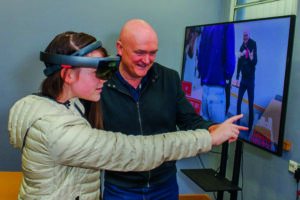
Of course, MediaCityUK is arguably the jewel in the crown of Salford, a triumphant example of what can happen when you put the private and public sectors together in a room to design a tech and media ecosystem propelled by wide-scale urban regeneration. The result is a cluster of cutting-edge accomplishments: in a UK first, the incredibly young city is now entirely 5G-enabled and centrally controlled via Internet of Things. “You have all the ingredients of a truly smart city in MediaCityUK: connected devices, connected spaces, building management systems, environmental management systems. This is a super-connected campus, with thousands of miles of fibre point to point. Even the piazza and streets have fibre ports in them,” revealed Jon. “I call it a mini Shenzhen, because it was built all in one go and it’s future-proofed from the ground up.”
To capitalise on this success story even further, MediaCityUK and The Landing will be launching a series of accelerator programmes thematised around certain elements of smart cities. The first one, Safe Citizen Lab, was launched this year in partnership with GCHQ and UP Ventures; the second, focused on urban spaces and property management, is due out in April. Naturally, this bodes well for a manmade city that is soon expected to physically double in size as part of Peel Group’s £1bn Phase Two expansion plan.
This is a super-connected campus, with thousands of miles of fibre point to point
Nevertheless, while it is home to the University of Salford, the BBC, ITV, and more than 250 businesses – including giants such as Ericsson, Kellogg’s, Huawei, and The Hut Group – there’s much more to Salford than just MediaCityUK.
With strategic growth locations including its city centre, GM Western Gateway, The Quays and MediaCityUK, Salford now boasts the fastest-growing economy in Greater Manchester, with the highest rates of employment on the back of a business base that has more than doubled since 2010. According to the city council, this phenomenal upsurge in growth isn’t down to luck: it’s the direct result of efforts to form mature public-private partnerships, with the last decade seeing inward private investment amounting to billions of pounds. This unprecedented cash injection has led to new commercial spaces, thousands more homes, better infrastructure and greener public realms, and improved cultural, health, and educational facilities. As the council put it, it’s “placemaking in action on accelerated scale.”
With this inward investment came a modernised approach to business, lifting Salford from the depths of its post-industrial decline to its new and elevated position as the bastion of creative, digital, and tech jobs. The cherry on top of the city’s digital revolution? Being named Digital Council of the Year at the prestigious Digital Leaders 100 Awards in 2018, just months after Jon took up his job as Salford’s first chief digital officer.
Off the back of that, and to capitalise on its own success story, the city banded together to launch a citizen-focused Digital Strategy late last year, outlining ambitious plans to become an internationally-recognised digital hub. The headline motto: “Salford will open up and connect its existing assets to enable collaboration and experimentation by a diverse range of emerging and established organisations.”
What’s under the bonnet?
While the launch of that strategy was certainly a landmark moment for the city, the masterminds behind its creation know that this bold vision far predates 2019. “This is all in our lifeblood, really,” claimed Debbie Brown, strategic director of service reform at Salford City Council. “Salford was right at the heart of the first Industrial Revolution, when cotton was a huge industry; the opening of the ship canal gave us access to that international trade and boosted the economy. Fast-forward to now, and here is Salford once again right at the heart of the Fourth Industrial Revolution.
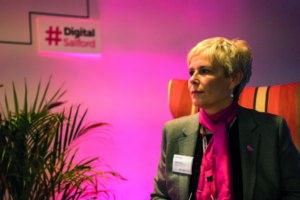
“We are an ambitious city: we’re entrepreneurial in our approach, but without losing that public service ethos that sits behind our work. For example, years ago the council was visionary enough to understand not to just close down the docks when they were derelict, but to actually invest in them. There were lots of people at the time who said we were barmy to spend money on an old dockland – and now The Quays have been completely transformed through digital. We’ve been really lucky to have the foresight of those who have gone before us to create that physical infrastructure. We’ve always been blessed with visionary politicians, with passionate decision-makers in the city who are up for making it work. It’s in our spirit.”
I’m not a techy person and I don’t do ‘tech speak,’ but I completely understand the value and importance of digital as a sector for the city
Like many of the people who can deeply appreciate the value of digital, Debbie’s professional background comes nowhere near the technology sector. Starting off in the (then public) electricity supply industry, she soon joined the local government family in 1992 where she focused on HR and organisational development, eventually becoming head of that service at Salford City Council. When an opportunity came up to work as its transformation lead, Debbie promised herself that no matter what challenges came up, her mentality would remain the same as that of her HR days: decisions must always be made based on people, not on technology. That ethos cuts right to the heart of the Digital Strategy.
“I’m not a techy person and I don’t do ‘tech speak,’ but I completely understand the value and importance of digital as a sector for the city and as an opportunity for the people of Salford,” she told Cityscape. “Ultimately, I’m interested in designing things that make other things easier. That’s what our digital transformation strategy is about: making services quicker, easier, and better, not just rolling out a chatbot because it looks interesting.
“The analogy I use is that of a car. If I want a car, then I want to know how many doors it has, how reliable it is, and whether it’s going to get me to where I want to go. I don’t need to know what’s under the bonnet or how all of that works – someone else will do that. What I need to be able to describe isn’t the car itself, but how I want to travel. That’s my separation between digital and IT, too: digital is about how we will live, work, and play in the future – something which I completely understand. But IT, or the wires that sit underneath that to make it happen – that, I haven’t got a clue about.”
In the same way that placemakers don’t have to understand technology to be able to describe what they want from it, citizens don’t have to be able to see technology in order to feel its benefits. For Debbie, smart-city technology should be invisible: “You should be able to walk around a city and all this tech just fires up for you when you need it, without you even knowing,” she said. “That, for me, is the utopia of it all. For example, we’ve all walked into my office and no one has talked about the fact that we have electricity – it’s just taken for granted; we don’t have to worry about it. That’s where we need to be with digital: it should just be there to make our lives easier, without us needing to think about it.”
Like Debbie, Salford City mayor Paul Dennett isn’t a tech expert by background – but that hasn’t stopped him from envisaging a future for the city that is substantially shaped by digital. In fact, it was his idea to create the chief digital officer role, and it was under his leadership that the Digital Strategy was published alongside the city’s private partners.
“I’ve always thought that it’s all about people, and not necessarily about technology. I know this might sound strange, but I often say the world is socially constructed: it’s about people coming together with ideas and innovations, trying to change things and make the world a better place, whilst also putting food on the table and paying their bills. For me, it’s the people-centric part of this that I’ve been most interested in as mayor. We don’t want anyone left behind in the Fourth Industrial Revolution,” Paul told Cityscape.
“So often our idea of ‘governance’ is bound by the organisations and the structures that we’re all very used to. But with something like digital tech and smart cities, and Industry 4.0 [a subset of the Fourth Industrial Revolution] more broadly, we need to think way beyond the boundaries of the local authority: how we collaborate locally, within the city region, and ultimately internationally with other places in the world.
“It’s about making sure the governance genuinely empowers people, as well as communicates clearly what we’re trying to achieve through the digital strategy. This isn’t just about what the city council does or what The Landing does; it’s about what goes on in the hospital, in the university, and in community organisations across the city. We must ensure there is that behavioural change, and that people feel part of a much bigger ecosystem.”
A tale of two cities
Keeping the spotlight on the people, and not the technology itself, is particularly crucial in a city blighted by socioeconomic inequality. Those who have visited Salford will certainly have noticed the striking difference between the bustling cultural epicentre at The Quays and the crime-ridden estates in neighbourhoods like Ordsall and Weaste, where the average life expectancy is almost 11 years lower compared to the better parts of the city. Homelessness is rife, gang culture is widespread, and fatal shootings are frequent. While the city’s economy booms, a quarter of its children live in abject poverty.

“We are a city of contrasts,” the mayor agreed. “We have poverty and inequality coexisting with growth. What’s more, the growth isn’t in all parts of the city, and the city as we know it today is very different to the historic city: in 1974, the geography of Salford changed. It’s now a collection of townships, in many respects. As a consequence of that, we have an ongoing challenge to link the growth in the city with tackling poverty, which is one of my priorities.”
Of course, the UK cannot turn the tide of poverty without reversing years of austerity politics, welfare reform, and deep public service cuts that have seen even the richest councils scramble for urgent solutions. But in the meantime, technology can lend a helping hand.
Using the government’s Index of Multiple Deprivation, the city council has been able to overlay data on the poorest areas with CRM information on who most interacts with the local authority through technology, a process which has helped uncover a correlation between the most deprived towns in Salford and the highest rates of digital exclusion. This can then inform how the council operationalises its accessibility work to target the right people, in the right communities.
CASE STUDY: Digital You
Thus was born Digital You, a unique cross-city, two-year programme that has been specially designed by the council and third-sector partner Good Things Foundation to equip mostly vulnerable residents with the tools and skills they need to thrive in a digital world.
For most, ‘digital exclusion’ brings to mind elderly citizens who don’t tend to have the same familiarity with technology as younger generations. But Digital You has shown that the root of the problem runs much deeper: digital exclusion can affect anyone, from those who are homeless or sleeping rough to those who have just come out of prison or who are recovering from addiction. Out of a population of just over 250,000 Salfordians, more than 15% lack basic digital skills, with Good Things Foundation putting this number at 24% – a figure above the national average.
To shift this paradigm, and to ensure that everyone can retain access to its services as they are increasingly digitised, the city council set itself a target: within two years, 8,000 more residents – at least 80% of them from socially excluded communities – would be online.
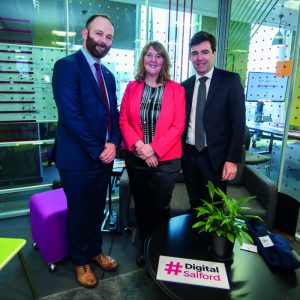
One year on from the start of the programme, which is spearheaded by Good Things Foundation, and it is already yielding impressive results: by the end of last year, Salford hit the 6,000-person mark, meaning it is on track to engage 8,000 people by this summer.
The pillar that props up this achievement is the programme’s sustainability focus. Rather than just giving residents access to equipment (even if this does also happen, with The Landing recently gifting £30,000’s worth of Apple computers to 12 Salford community organisations), the Digital You team is working directly with community organisations to communicate the importance of this project and help them bake digital into their day-to-day mission.
“What we have now is a network of online centres through the city, mainly in our areas of multiple deprivation, that are staffed by volunteers and community champions,” said Debbie. “We do a lot of outreach work with particular groups, too, such as with refugees and asylum-seekers, the Salford Unemployed & Community Resource Centre, the Salford Lads’ Club, Salford Loaves and Fishes… All of the places where our most disadvantaged people will go to for support.”
According to Adam Micklethwaite, director of digital social inclusion at Good Things Foundation, these community groups tend to be modest in size and in budget. Many have been fighting for survival after years of progressively scarcer government support, powered instead mostly by the goodwill of its volunteers who manage to keep these groups afloat against all odds.
“As a charity, we not only try to help members of the public to improve their digital confidence and skills, but we are also very aware of the need for a thriving community sector to support this kind of activity. As a result, we do a lot of work to try and bring as much funding into that sector as we possibly can,” explained Adam.
“In Salford, we have been working with people like Jon Corner and his connections in the city (particularly with the private sector), as well as with the council and the connections it has with other representative bodies (such as Age UK or Citizens Advice), to create an alliance for digital inclusion that can support this programme going forward – once Good Things Foundation bows out. Then, ideally through the private sector but perhaps through other funders, there can be a way to ensure that the programme continues. Rather than a programme extension, I’d call it sustainability: making sure that these approaches can be properly embedded and become part of the fabric of what Salford does.”
With that determination comes innumerable challenges. Many organisations would love to take part in the programme, but don’t have the money or the time to devote to it. In Salford, several groups needed high levels of support to move past these limitations; this was facilitated by what Adam calls ‘activation grants,’ which enable organisations to activate their digital capability for the first time. Yet even with these bespoke grants in place, a fair few required significant face-to-face contact before they felt like they could fully trust the programme’s vision and, consequently, immerse themselves in the digital world. But once they feel confident enough to take the plunge, the opportunities ahead for the people of Salford are limitless.
One of those people is Alan. Due to ongoing health problems and frequent blackouts, he was unable to hold down a regular job and often had to force himself to go to work with major injuries such as concussions or busted ribs. Traditional physical jobs in warehouses, for example, were suddenly off the table. To circumvent this, Alan decided to establish the Digital Phoenix Society, which he hoped could train up digital champions to help those with mental health conditions and disabilities to gain digital skills. But just as funding streams began to prove inexistent and the desire to empower others like himself started to feel like a pipedream, Alan came across the Digital You programme. Based at the Langworthy Cornerstone community centre, he now runs an informal digital skills drop-in session every Thursday afternoon where those whose health prevents them taking part in long computer courses can access support in a relaxed, informal environment. 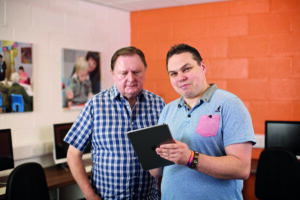
“There have been a lot of stories, but one of the main ones that will always stick in my head was the guy who had never used a computer in his life,” said Alan. “He didn’t have an email, so I had to create one for him. I then got him on Indeed and showed him how to use it; as he was going through the website, I showed him how to do job searches. The following week when I came back, I kid you not, [my colleague] pulled me to one side and said: ‘You know that bloke you helped apply for a job? He’s had the interview, and he’s got it!’”
It’s as Adam put it: as well as equipping people with the skills to get a job in the first place, Digital You helps them to retain that job – because digital skills are now an employment premium – and to easily find other opportunities online.
It stretches beyond employability, too. “It’s all the things that we take for granted: being able to shop online at the touch of a button and the associated cost savings of travel that you might get from that. Being able to communicate more immediately and more directly with friends and relatives. Being able to manage your health and wellbeing using digital health tools,” listed Adam, whose own father is a good example of someone who uses apps to monitor his respiratory condition. “There is a general increase in confidence that being able to use digital technology brings. We’ve seen it have a strong impact on your confidence as a learner, which is a very powerful thing that can really reinforce your sense of self-worth. There is a whole range of different ways through which digital can change your life. At Good Things Foundation, we believe that technology, and the digital world, can be – and should be – a force for good.”
Deep dive: Salford Royal
Like Adam’s father, there has been a surge in the number of people looking to wearables as a handy way to self-manage health conditions instead of visiting the GP on a weekly basis. This is something that Salford Royal, an Outstanding-rated NHS foundation trust considered one of the best in the UK, has been familiar with for years: back in 2017, for example, it sealed a deal with US data platform supplier Validic to upload patient-generated wearable data to its Allscripts electronic patient record (EPR). This would be used to build more personalised care pathways: for instance, clinicians would be able to use a patient’s exercise data or heart rate information to assess their metabolism and modify medication accordingly.
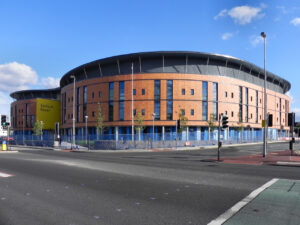
But Salford Royal’s digital work spans further than this, and has been going on behind the scenes for much longer than wearable devices have been around. Raj Jain, the trust’s chief executive, who took over the reins of the Northern Care Alliance NHS Group from Sir David Dalton last year, traces Salford’s history of digital back to a man by the name of Dr Bob Young.
Now retired, Bob used to work in Salford Royal’s diabetes and endocrinology department as a consultant physician. Fuelled by a personal interest in technology, he tasked himself with finding a solution to the data problem that blighted the NHS (and still does, in many ways): Bob was after a way to connect data between primary care and the hospital in order to improve the management of diabetes.
Raj believes that Bob was a visionary, ahead of his time in his approach. “He was a pioneer,” the CEO said. “He really pushed the boundaries around our data and connectivity in the mid- to late-90s.”
The clinical management system put in place for diabetes – whose design was informed by patients – was soon expanded to encompass the whole of primary and secondary care for people on different disease registers, such as coronary heart or chronic kidney diseases. This independent and locally designed system meant that Salford Royal chose not to take part in the massive £6bn National Programme for IT, an initiative launched by the Department of Health in 2002 designed to move the entire NHS towards a single, centrally mandated electronic care record for patients. Raj, who was part of Salford Royal’s executive team at the time, saw first-hand how the decision to forge ahead autonomously wasn’t an easy one, especially since the government refused to give the trust any money as a result. But it proved to be the right one – not least because the multibillion-pound programme failed to deliver on its aims, as concluded by a Cabinet Office review in 2011, since it was “no longer appropriate for a centralised authority to make decisions on behalf of local organisations.”
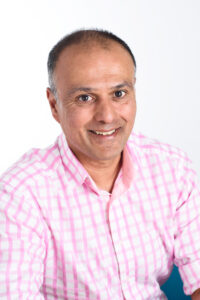
In fact, opting to stick with the integrated system already in place may just have been the watershed moment that would eventually propel the foundation trust into nationwide recognition as one of just a few providers chosen to become an Acute Global Digital Exemplar (GDE). According to NHS England, such status makes Salford “an internationally recognised NHS provider delivering improvements in the quality of care through the world-class use of digital technologies and information.”
The GDE label, however, is not one that Raj himself readily uses. Indeed, for a trust that has long been involved in digital innovation, it can seem effectively redundant. But it does allow Salford to export its expertise and product innovation both domestically and abroad, gifting these best-practice blueprints to other trusts in the country while selling them to international partners.
“The GDE is a catch-all name, really,” said the CEO. “Underneath it, you have some requirements to meet in order to get to HIMSS Level 7 [a benchmark for the use of advanced and high-quality IT], so there are a series of projects that fall under that. But this is all part of our overall approach to digitisation, which we call Future Digital.”
Future Digital was launched as a follow-up to the GDE programme in the hopes of continuing the development of digital maturity across the local NHS estate. Central to this is Salford Royal’s Digital Factory: though it sounds like a physical place, the Factory is essentially a way of working, which allows staff and outside companies to test different tech applications before rolling them out.
“What became clear to us a number of years ago is that we could pick a solution which, on the face of it, would seem good – but it wasn’t until you could run it in practice that you truly understood the costs of ownership and whether it was going to deliver the intended benefits,” explained Raj. “The Digital Factory is therefore a method of evaluating solutions to determine whether they have good staff usability. Do staff like it and think they can use it in their day-to-day work for a good benefit? Is it interoperable with our EPR system? If it isn’t, it won’t go anywhere. Is its cyber security affordable? Often with these systems it’s not, so that will kill the solution dead. And lastly, can we develop an effective business case that will justify the investment in that solution?
“Sometimes the Digital Factory is a place, but that’s not really the heart of it; its heart is out on the wards and theatres. For example, for one solution we had nearly 1,000 staff going through it and evaluating it. That’s enormously powerful for us to be able to say whether the solution will actually yield the benefit we want.” 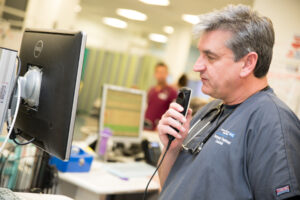
This is also enormously attractive to private companies, which are able to get a thorough product evaluation that is second to none. “We’ll charge companies to use our Digital Factory because it’s a very valuable asset,” continued Raj. “International companies want to play with the NHS because it’s a very strong brand abroad, so it gives them a stamp of authority. And what they get here is access to some of the best clinical minds; they can’t buy that anywhere – not in the scale that we offer. We have 2,000 doctors here. Even the largest companies can’t get access to that without it being extraordinarily expensive. So that’s the deal: they invest here, we invest our time, and we can make some magic together.”
For this very same reason, private companies are also keen to help Salford Royal set up its own set of onsite 5G suites to enable a series of pilot tests that would harness the latest-generation wireless technology for the benefit of the MedTech community. Take diagnostics, for example: with 5G, Salford Royal could put an end to the outdated model of residents queuing up in the outpatient department waiting to be checked by large in-house machines. “There’s an initiative that we have called the Rapid Diagnostics Centre, where we want to diagnose cancer within 14 days – currently, it can take a lot longer,” commented Raj. “The vast majority of cancers are currently diagnosed at stages 3 or 4. If you can do quicker and cheaper diagnostics, you’re more likely to diagnose stage 1 or 2 cancers, which are much more operable – meaning patients are more likely to live.”

The foundation trust hopes to have these 5G suites in place this year, so long as private partners remain enticed by the unique opportunity to develop cutting-edge medical solutions in one of the best hospitals in the world. Once rolled out, it will be yet another success story in Salford’s adoption of 5G, taking it beyond the boundaries of MediaCityUK and into the real world.
Beyond 5G, more good news is on the way for Salford Royal this year, not least of them being a new £67m major trauma centre, the construction of which is due to start soon after plans were approved in December. Serving the sickest patients from across all of Greater Manchester, the trauma centre will feature six storeys, five theatre suites, and its own rooftop helipad. Digital, of course, will be at the heart of it all: technologies such as 3D-printed hip plates, for example, which can be manufactured in minutes without the need for further tweaking once placed on the patient’s body, will be commonplace at the centre. Not that Salford needed to do anything else to solidify its already-established reputation as having the country’s best trauma outcomes, of course.
Many other digital schemes will be explored this year, spanning everything from automation and robotics to smartphone apps and electronic care pathways (as Raj put it: “We actually have to control the number of opportunities and projects we take on, because we have too many.”) But one project towers over all the rest, standing out as Salford Royal’s magnum opus for 2020: a five-year initiative to create a brand-new Digital Control Centre from scratch.
“The best analogy is that of an airport,” explained Raj, who said the control centre scheme is the project he’s most looking forward to this year. “You need a control centre to direct planes to safety, a mechanism to get people off the plane and reunite them with their baggage – that kind of thing. Most hospitals are like airports, but without a control centre.”
In a £25m partnership with Hitachi Consulting, Salford Royal wants to spearhead the novel proposition of creating a physical control centre that can oversee the flow of the thousands of activities taking place simultaneously within the organisation. The intelligent system is expected to free up beds, operating theatres, and equipment, all while making staff happier by allowing them to automate some of the time-consuming processes that are currently carried out by filling forms and chasing data.
The first phase of the project, which kicks off this year, will focus specifically on urgent care by introducing patient insights and flow management tools to give NHS staff real-time information relating to attendance and admission history, clinical indicators from patient history, admission risk, and standard patient scores. In other words, it will ensure that frontline workers are able to assign patients to the correct care pathways. If all goes to plan, the control centre will be wholly revolutionary.
Plans for 2020
Outside of the four walls of the hospital and out into the local community, there is also much to look forward to this year. Salford City Council and partners will continue to develop their many ‘digital-first’ programmes that have already been taking root in the past few months.
MyCitySalford, for example, is Salford’s local (and community-owned) take on Facebook: it’s an online social prescribing portal that brings together businesses, organisations, and individual residents in a friendly environment where they can access essential public services and advice, as well as discuss topics relevant to their local areas and support each other in taking action. From interactive forums to information on local events and business discounts, MyCitySalford offers a little something for everyone.
Advertised within MyCitySalford is another one of the city council’s digital projects, BetterOff Salford, which was designed to tackle poverty and inequality by equipping citizens with the guidance and tools they need to help themselves. In essence, it’s an online one-stop shop for accessing benefits, jobs, childcare, information on debt and financial management, and everything in between. For those who prefer a more personal touch, BetterOff also hosts weekly coffee and chat sessions where members of the community can drop in for support on a wide range of social issues.
In a completely different vein, the city will be pressing forward with its leading-edge Automated Vehicle Initiative, led by the university in partnership with Digital Salford. Taking advantage of MediaCityUK’s status as a private site rather than a public realm, the partners have been piloting the use of autonomous shuttles and electric scooters, with a 2020 journey planned between the Peel Group campus and Salford Crescent station.
As well as expertise in autonomous travel (it even offers undergraduate and Master’s degrees in self-driving vehicle technology), the university is also home to the world’s only fully climate-controlled, brick-built research facility. Energy House, a full-sized, two-bedroom terraced house, was reconstructed inside an environmental chamber replete with sensors that can replicate almost any weather condition, from a scorching summer’s day to a freezing winter’s night – and all the rain and wind that comes with that. A centrepiece of the university’s focus on energy, the facility was designed to help scientists and researchers develop new solutions that can improve the energy efficiency of properties by testing new materials, systems, and technologies.
Smart people make smart cities
The underlying golden thread that keeps all of Salford’s various digital projects firmly in place is access to the appropriate skills within the local population. After all, without the right people, ideas run dry and projects falter.
That is, of course, easier said than done, especially in a country – and in a world, more broadly – where digital skills shortages threaten to hit alarming highs. Even distinguished tech giants have made clear that the gap in the skillsets required to manage exponentially larger amounts of data will pose a significant challenge; back in 2016, IBM estimated that by 2020, we will suffer from one million unfilled jobs in the technology sector – primarily because the skills of today aren’t the right skills for tomorrow. A 2018 study by Deloitte discovered that just 16% of executives believe their teams have the right capabilities to deliver their digital strategy, and only 12% of respondents thought UK school leavers and graduates have the right digital skills. The lion’s share of employers are experiencing difficulties in recruiting the right staff, especially data scientists and analysts. In Greater Manchester, skills supply continues to fall behind demand for permanent jobs, and developer roles are tough to fill. From the younger generations all the way to the senior ranks of major companies, it seems like the skills agenda is nothing if not a ticking time-bomb.

Jon Corner wants to shift this paradigm – at least within the confines of Salford. His interest in the area meant that the Digital Strategy featured the importance of digital skills front and centre, especially regarding early education: at present, an institution can achieve an ‘outstanding’ Ofsted rating without its curriculum even as much as mentioning digital.
Looking for a fix, Jon offered to help out his next-door neighbour, a brand-new, purpose-built UTC school for 14- to 18-year-olds specifically designed to ensure the future employability of students within the digital media sector. “What that work made me realise is that there’s a real disconnect between the ambition amongst entrepreneurs in different digital sectors to share their skillsets, and the capabilities of the school system to be able to welcome them in,” he told Cityscape. “In schools right across the UK, our teachers are under so much pressure to deliver the basic curriculum that digital is just background noise for them.
There’s a narrative around digital as a physical process, a device or a way of connecting to the internet – but it’s not. It’s a different way of thinking about the world, and about how you fit into it
“It’s not even just about kids using tablets or smartphones,” he continued. “It’s being able to inspire young people to know what the opportunities are in this sector. If they can be introduced to entrepreneurs who are only a few years older than them, who can tell them about their journey and how they can do it too – there’s no better interaction than that.”
Jon has planned out a “whole series of programmes” for 2020 that will seek to make the city’s dearth of digital skills a thing of the past (and it wasn’t just hot air, either: on the whiteboard behind him was an impressive mess of scribbles with different ideas and planned projects within this theme). The Landing itself will become a “pivotal hub” where young people can drop by, work alongside entrepreneurs, and gain exposure to what the tech field is all about. If it were up to Jon, digital would be part of the core curriculum; while that’s not yet the country’s reality, he is harnessing the help of outside companies to inspire the workforce of the future and enact change on the ground.
“There’s a narrative around digital as a physical process, a device or a way of connecting to the internet – but it’s not. It’s a different way of thinking about the world, and about how you fit into it,” said The Landing’s boss. “That message is not embedded in our schools. I have three kids myself, and none of them learn about digital in school; they do it with me, at home.”
In the city council, Debbie Brown has tasked a cross-sector team with pulling together a skills and work pipeline that can accompany the Digital Strategy. Part of that are projects like Digital You and Digiwise, a CPD-accredited mainstream education initiative, but another key component will be focused on getting students interested in the technology sector from a young age – particularly those who show signs of having an entrepreneurial spirit but may be academically underachieving. 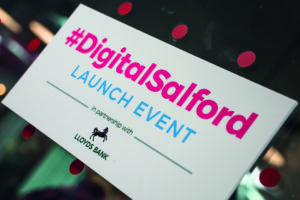
Paul Dennett has similarly taken up the challenge of prioritising internal skills development as part of his mayoralty, highlighting the council’s work with Barclays in training up almost 500 ‘Digital Eagles’ as a phenomenal example of what can be achieved when multiple sectors come together. “Digital Eagles are people who have been trained to pass on digital skills and experiences to other people in the council,” said Paul, who, like Jon, believes that digital should be as much a part of the national curriculum as arts, culture, and creativity.
All in all, investment in modern skills alongside infrastructure, enterprise, and public-sector capabilities forms the backbone of the Digital Strategy, which itself is driven by a bold vision: “To make Salford the most attractive city for digital enterprise and to establish Salford as a leading digital economy and, in doing so, to ensure that innovation and growth is directly connected to outcomes for Salford people.”
For a city still trying to undo decades of chronic poverty and deprivation, many would argue that Salford’s road to ultimate smart-city success will be long and winding. And they would be right, but not for the reasons they think. Because for a group of people with tenacity coded into their very DNA, a smart city could never be smart enough; instead, success should be characterised as milestones rather than as a final destination. So don’t hold your breath for a curtain call: the smart city of Salford will always remain in flux.

